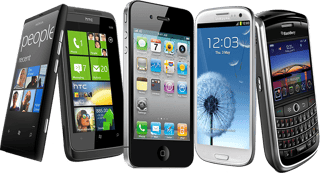 BYOD (Bring Your Own Device) has been increasing in popularity as more and more companies are seeking to cut costs and boost productivity. However, there have been arguments that implementing BYOD has hidden costs that could outweigh its benefits. How much does BYOD save your company, and is it worth it to implement?
BYOD (Bring Your Own Device) has been increasing in popularity as more and more companies are seeking to cut costs and boost productivity. However, there have been arguments that implementing BYOD has hidden costs that could outweigh its benefits. How much does BYOD save your company, and is it worth it to implement?
Time Savings:
BYOD does indeed improve worker productivity. According to Cisco, the average BYOD user in the US saves 81 minutes per week. In addition, BYOD sparks employee-led innovation in developed countries and reduces productivity losses in emerging markets (Cisco IBSG 2013). Cisco also found that 36% of users are “hyperproductive” with their own device, saving at least 2 hours per week. 21% save at least 4 hours per week.

In addition, after BYOD implementation, you will save training time as well. Employees are already familiar with their own devices, so any apps or new software you choose to install on their phones will not seem as foreign. Employees also typically have the most up-to-date technology, so the time it takes to complete each activity will also be reduced.
As is seen below, 65% of iPhone users have the iPhone 5 or iPhone 6, with the average device age under 800 days. Almost all users have iOS 7 or 8, which are the two newest iOS updates to the software.

Source: david-smith.org
Android users have similar statistics. In addition, 81.1% of Android users have the 4.1x or newer operating platforms, suggesting that they not only upgrade their phones regularly, but also their operating systems.

Source: developer.android.com
Financial Savings:
Companies save on costs in 3 categories: hardware, support, and telecommunication.
-
Hardware: The average user will spend $965 on their device. This is a cost that is now moved from the company to the employee. Also, companies have to purchase new phones periodically in order to stay up-to-date on technology. This cost will be eliminated by BYOD because the user automatically will update their phone if they are not content.
-
Support: By implementing community support, wikis, forums, and other streamlined support options, companies can save $26 per user in the US and $8 per user across all the countries.
-
Telecommunication: Since you will be moving employees from corporate data plans to self-funded plans, you can save an average of $734 per user. Companies can typically migrate 20% of corporate users to a self-funded plan.
Additionally, with the 81 minutes of time saved, this amounts to $1,518 saved (based on the average salary), according to Forbes magazine. If you combine this with the money saved from the actual cost of the device ($965) and the cost of the data plan ($734), employers save $3,217 per user.
Cost Increases:
BYOD doesn’t come without increased costs - your company may find that application security, back-end infrastructure, policy development, program management, and regulatory compliance fees will increase. A big part of this cost increase is the implementation and management of a MDM (mobile device management) system.
In addition, BYOD policies often lead to employees filing more expense reports since they have more control over their phone. According to the Aberdeen Group, one expense report costs about $18 to process.
Corporate discounts are a big factor to those who argue for COPE (Company Owned Personally Enabled) devices. Since companies can take advantage of volume discounts on devices and have corporate discounts on voice and data plans, it costs less for them to purchase devices and plans than it would for employees. With company discounts, a plan would cost around $50 per user, while a similar plan would cost an employee a minimum of $80 per user. This would amount to $360 more per employee per year. Companies using COPE would not have to pay stipends to employees for devices or subsidize plans.

Ultimately, companies using BYOD save on capital expenditures, while COPE may save companies on operational expenditures. It is important to analyze which will save you more in the long-run, but also to determine which is better suited to your company and its culture.
The Final Verdict
Although companies can take advantage of discounts on device and data purchases, BYOD cost savings far outweigh CYOD or COPE cost savings. With BYOD, you can save money on the cost of the device, the support and training for the device, and even the telecommunication. More importantly, BYOD increases productivity and innovation among workers, saving you and your employees valuable time. These factors, in addition to the research that employees prefer using their own device, cause an increase in employee satisfaction and happiness.
By clearly defining BYOD use and creating an acceptable use policy, you can counteract many of the infrastructure and management costs. If you ensure accountability using Field Activity Management software that reps can download onto their phones, you can take advantage of additional cost savings, as Field Activity Management software is cheaper than CRM. Take this cost saving analysis into consideration when you perform your own on your company and determine if BYOD is the right policy for you.


 BYOD (Bring Your Own Device)
BYOD (Bring Your Own Device).png?width=480&height=252&name=PRESS%20RELEASE-2%20(4).png)

